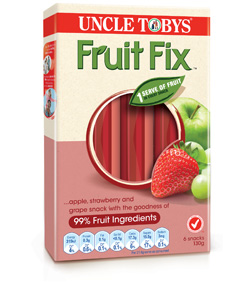Why is the Australian Heart Foundation handing out ‘ticks’ to confectionary?
Over the last few weeks I’ve been having a bit of a go at Nestle. I’ve been worried that when they tell children that their Fruit Fix confectionary is equivalent to ‘1 Serve of Fruit’, they may be misleading the little dears (and their mummies and daddies). The product is almost three quarters sugar and while that makes it a candidate for lolly of the year, I think it’s a bit of stretch to market it as ‘natural and nutritious’.
When Nestle wrote back and protested their innocence, I was a little surprised that they didn’t wheel out the one obvious defence they did have to my assertions. Surely they could accuse me of outrageous plundering of public sensibilities by simply pointing to the little red tick on the front of the box? You see, our little fruit flavoured friends have been ‘tick approved’.
That’s right, none other than the Australian Heart Foundation has certified Fruit Fix as tick worthy.
I immediately dashed off an email to the heart foundation to check that it was true (you can’t be too careful in these days of dodgy emails and made-up utes – or was that made-up emails and dodgy utes?). And blow me down if it wasn’t so. They explained that the reason that Fruit Fix had earned their stamp of approval was that:
“Fruity [sic] Fix’s sugar content comes entirely from sugars that occur naturally in fruit – they are not added sugars. In order to earn the Tick on this type of food, the product must be at least 95% fruit. [their emphasis]”
Now, I suspect (like a lot of consumers), you’ve never really looked into what a heart foundation tick means. I’ve just assumed that they are hard to get and a product that has one must be really good for me. I mean if the heart foundation gives it a tick, it must mean it’s good for (at least) my heart, right?
The heart foundation website does certainly encourage that perception. They proudly report that ‘The Tick is the Heart Foundation’s guide to help people make healthier food choices quickly and easily’ and ‘Tick foods offer not only a healthier choice but truth in food labelling too.’
They’ve also done quite a bit of research on how we perceive the tick. The data tells them that they’ve been very successful in promoting the tick as a brand that consumers respect and value as a stamp of approval for healthy foods. Thirty percent of us actively look for products with a tick and 78 percent regularly or sometimes use the tick when shopping for food.
With that kind of marketing firepower behind it, you can be sure that any manufacturer aiming at the kiddy market would give their left arm, leg, well anything, to have the tick stamped on the label. A mother that walked past a tick certified snack for little Johnny and chose a plain ol’ unticked bar instead would have to be certifiable herself, surely?
But that kind of power brings a truckload of responsibility. We trust the heart foundation to guide us through the maze of food labels and health enhancing claims (from ‘iron man food’ to ‘50 % more calciYUM’). We believe the Australian Heart Foundation when they tell us a food is ‘a healthier choice’. We pay that bit extra based entirely on their assurance that we can do no better for Muffy and Geronimo. All we ask in return is that they be right.
When the heart foundation started handing out ticks twenty years ago, science knew very little about how our bodies process sugar. One of the core hormones involved wouldn’t even be discovered for another five years and many of the critical studies were not even a gleam in the researcher’s eyes. The evidence linking sugar to heart disease was still thin on the ground. So it’s easy to understand how the criteria for the allocation of a tick might not pay too much attention to sugars.
But today, the science is done, the evidence is in and it’s unequivocal. Sugar consumption is the most significant factor in the accelerating incidence of heart disease, diabetes, obesity and a raft of associated illnesses. In that context, to certify as safe, a product which is almost three quarters sugar is outrageous. This is even more so, when the certifying organisation knows how much we rely on their stamp of approval.
There is no ‘added sugar’ in Fruit Fix, but that does not mean there is no sugar. Sugar is sugar is sugar. No sane chemist would argue that a sugar molecule that once formed part of a piece of sugar cane is any more or less ‘sugar’ than one which was part of an apple or a banana or a strawberry. It doesn’t come as too much of a shock if a marketer (with a product to sell) is deliberately misleading when they justify high-sugar products on the basis that fruit was in some way involved in their construction. It comes as a mighty big surprise (and somewhat of a disappointment) when a self-appointed watchdog does the same.
I had always believed (like most of us, I suspect) that the Australian Heart Foundation was a powerful force for good in ensuring we are all eating better. But, for the tick program to retain any relevance, the heart foundation must ensure that it is up with the latest science. And it must guard against abuse of the program by those skilled in making semantic arguments. Whacking a tick on a children’s food product that has more sugar than a Mars Bar (simply because its sugar came from fruit rather than cane) is at best irresponsible and at worst, child abuse.



















Recent Comments